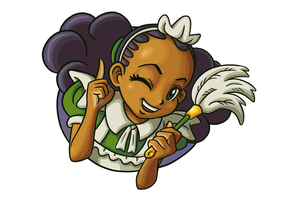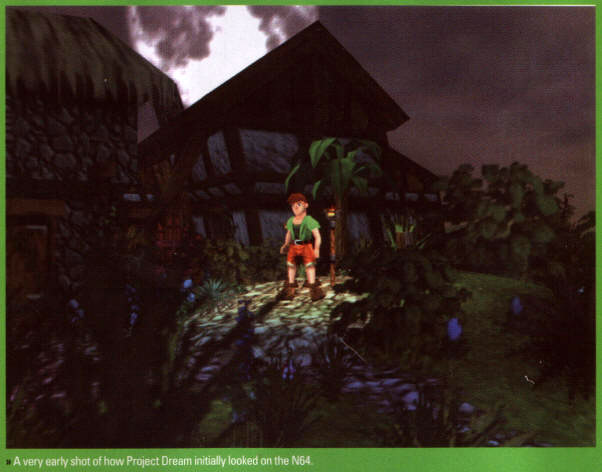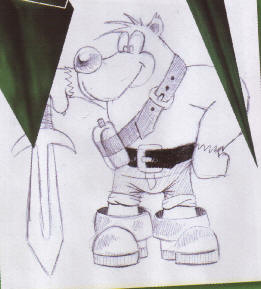Project Dream (lost builds of cancelled Super Nintendo/Nintendo 64 precursor to "Banjo-Kazooie" platformer; 1994-1997): Difference between revisions
mNo edit summary |
No edit summary |
||
| Line 5: | Line 5: | ||
|status=<span style="color:red;">'''Lost'''</span> | |status=<span style="color:red;">'''Lost'''</span> | ||
}} | }} | ||
[[File:Project Dream SNES.png|thumb|300px| | [[File:Project Dream SNES.png|thumb|300px|Screenshot of the planned SNES version.]] | ||
Project Dream was a cancelled video game created by Rare | '''''Project Dream''''' was a cancelled video game created by Rare. | ||
It first started being developed for the Super Nintendo in the mid-1990s, until it was rebooted as a Nintendo 64 title. | |||
The original project was meant for it to be an RPG with many features. However, more and more modifications were brought to the development until it eventually became the platform game ''Banjo-Kazooie''. | |||
==Plot== | ==Plot== | ||
The game's protagonist would have been Edison, a boy armed with a wooden sword. He would have confronted pirates and their leader Captain Blackeye, who would have served as the game's villain. | |||
Very little details of the plot and game elements have surfaced otherwise. | |||
{| style="margin: auto;" | |||
|[[File:Lmwtan cleanup.png|frameless|300px|link=LMW-tan]] | |||
|This part of the article has been tagged as <span style="color:blue">'''Needing work'''</span> due to its plagiarism. | |||
|} | |||
==SNES version (1994-95)== | |||
Development first started on Project Dream in 1994-1995 (exact date unknown). The game would have used the same ACM (Advanced Computer Modeling) technique that was used for Donkey Kong Country in 1994. According to composer Grant Kirkhope, composer of the game (and the eventual Banjo-Kazooie), a demo had already been created when he joined on October 1995. He states that he was “blown away; it looked beautiful and was obviously going to be a big step up from Donkey Kong Country. The demo had a full introduction sequence and a full level. | Development first started on Project Dream in 1994-1995 (exact date unknown). The game would have used the same ACM (Advanced Computer Modeling) technique that was used for Donkey Kong Country in 1994. According to composer Grant Kirkhope, composer of the game (and the eventual Banjo-Kazooie), a demo had already been created when he joined on October 1995. He states that he was “blown away; it looked beautiful and was obviously going to be a big step up from Donkey Kong Country. The demo had a full introduction sequence and a full level. | ||
| Line 30: | Line 40: | ||
On 12/22/15, Rare released a video on their YouTube page entitled: "Rare Revealed: A Rare Look at Dream". The video shows, and tells of the development history of Dream, including some never before seen gameplay of the SNES version of Dream, The N64 Version of Dream, and a very early prototype of Banjo Kazooie. The video can be seen here: {{#ev:youtube|https://www.youtube.com/watch?v=w72kj20YNA0|320x240|center||frame}} | On 12/22/15, Rare released a video on their YouTube page entitled: "Rare Revealed: A Rare Look at Dream". The video shows, and tells of the development history of Dream, including some never before seen gameplay of the SNES version of Dream, The N64 Version of Dream, and a very early prototype of Banjo Kazooie. The video can be seen here: {{#ev:youtube|https://www.youtube.com/watch?v=w72kj20YNA0|320x240|center||frame}} | ||
==Resources== | ==Resources== | ||
*[http://www.unseen64.net/2008/04/04/project-dream-banjo-kazooie-proto-beta/ Information about the game on Unseen64] | |||
http://www.unseen64.net/2008/04/04/project-dream-banjo-kazooie-proto-beta/ | *[http://grantkirkhope.com/dream.html Grant Kirkhope talking about this working on the game] | ||
*[http://banjokazooie.wikia.com/wiki/Project_Dream Game's article on the Banjo Kazooie wiki] | |||
http://grantkirkhope.com/dream.html | *[https://www.youtube.com/watch?v=w72kj20YNA0 - Rare Revealed: A Rare Look at Dream.] | ||
http://banjokazooie.wikia.com/wiki/Project_Dream | |||
https://www.youtube.com/watch?v=w72kj20YNA0 - Rare Revealed: A Rare Look at Dream. | |||
[[Category:Lost video games]] | [[Category:Lost video games]] | ||
[[Category:Needing work]] | |||
Revision as of 19:04, 3 April 2017
Project Dream was a cancelled video game created by Rare.
It first started being developed for the Super Nintendo in the mid-1990s, until it was rebooted as a Nintendo 64 title.
The original project was meant for it to be an RPG with many features. However, more and more modifications were brought to the development until it eventually became the platform game Banjo-Kazooie.
Plot
The game's protagonist would have been Edison, a boy armed with a wooden sword. He would have confronted pirates and their leader Captain Blackeye, who would have served as the game's villain.
Very little details of the plot and game elements have surfaced otherwise.

|
This part of the article has been tagged as Needing work due to its plagiarism. |
SNES version (1994-95)
Development first started on Project Dream in 1994-1995 (exact date unknown). The game would have used the same ACM (Advanced Computer Modeling) technique that was used for Donkey Kong Country in 1994. According to composer Grant Kirkhope, composer of the game (and the eventual Banjo-Kazooie), a demo had already been created when he joined on October 1995. He states that he was “blown away; it looked beautiful and was obviously going to be a big step up from Donkey Kong Country. The demo had a full introduction sequence and a full level.
Eventually, it was decided that the SNES was not powerful enough for the development team’s vision, so the project was switched over to the SNES’s successor, the N64.
N64 version (1996-97)
Development on the N64 version started on the N64 Disk Drive, in which the game would have switched to a 3D RPG game in the same vein as The Legend of Zelda: Ocarina of Time (which was also still in development at the time). This version would have had a unique 3D terrain system, created by stretching out the polygons. The processing power of the N64, however, was not enough to render these environments at a steady framerate.
The development team had also taken notice of the second Rare team who was developing Twelve Tales: Conker 64 (a cutsey platformer inspired by Super Mario 64 that would later become the adult-orientated Conker’s Bad Fur Day). From that, the team decided to switch gears to a platformer with RPG elements. It was also noted that the main protagonist Edison was “too generic”, so the team looked for a new character, mainly woodland animals for inspiration. They eventually settled on a bear, who was initially a secondary character in the game, and he became the character Banjo.
In the end, the whole project was scrapped, and the team started over with some characters from Dream for a new game: Banjo-Kazooie.
Music
Also worth noting is the musical score, composed by Grant Kirkhope. According to him, he composed over 100 tracks for Dream. While most of them have not surfaced since the project’s cancellation, some songs are available on his website.
Footage
On 12/22/15, Rare released a video on their YouTube page entitled: "Rare Revealed: A Rare Look at Dream". The video shows, and tells of the development history of Dream, including some never before seen gameplay of the SNES version of Dream, The N64 Version of Dream, and a very early prototype of Banjo Kazooie. The video can be seen here:


